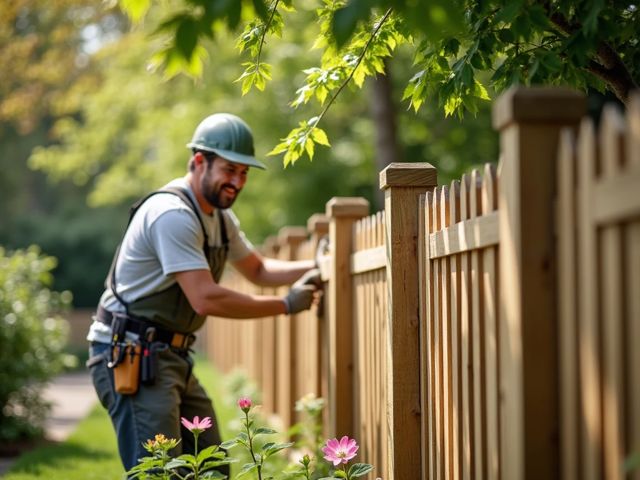Weather considerations for fence installation include seasonal benefits like the moderate temperatures in spring, which ease ground work and enhance efficiency. Additionally, fall installations help prevent issues such as wood warping and allow for quicker project completions due to reduced demand for services.
Spring Weather Benefits for Fence Installation
Spring emerges as a favorite season for many outdoor projects, particularly fence installation. The benefits of setting up a fence during this time are numerous, ranging from favorable weather conditions to practical timing in anticipation of summer activities.
One of the principal advantages of spring is the moderate weather. As the harshness of winter gives way, the ground thaws and becomes easier to work with, simplifying the process of digging post holes that are essential for a sturdy fence. This period of clear skies and comfortable temperatures enhances work efficiency, whether you’re tackling the project on your own or hiring contractors.
Spring installation preps your space for the summer. With plans often including garden landscaping and increased outdoor activity, having a fence up provides both security and privacy. It shields budding gardens from being trampled by pets or wild animals and provides a safe play area for children. This timing avoids the peak season for contractors, meaning shorter waiting times and potentially lower costs.
Strategically, setting up a fence in this season supports other upcoming summer tasks. With your fencing needs sorted early, you can focus on additional landscaping or home improvement projects as the weather continues to improve. For families, having a secured and well-defined outdoor space is crucial for ensuring a relaxing and enjoyable summer.
Finally, consider the aesthetic benefit. Installing your fence in spring allows it to integrate with your garden as everything blooms. This timing ensures that by the peak of summer, your yard is not only functional but also aesthetically pleasing, complemented by a fence that integrates seamlessly into a lush landscape.
For those considering this home improvement, products like the Greenes Picket Fence can provide a charming and effective option to enhance the boundary of your property.
In summary, spring signals a fresh start and serves as an optimal moment for installing fences, combining practical benefits with preparation for a lively summer ahead.

Summer: Peak Conditions and Strategies
Summer presents optimal conditions for installing fences due to longer daylight hours and generally predictable weather patterns. This period is filled with activity as many homeowners decide to enhance their property with new fencing. To manage the high demand effectively and ensure timely project completion, here are some practical strategies:
Advanced Planning and Material Sourcing
Begin by securing all necessary permits and familiarizing yourself with local zoning laws that may affect your fence installation, including height restrictions and boundary rules. Early planning also involves purchasing high-quality materials. For those considering wood alternatives, products like the Greenes Picket Fence offer durability and aesthetic appeal.
Professional Consultation
Engaging professionals can reduce the time and stress associated with DIY projects. Experts handle everything from material sourcing to actual installation, ensuring compliance with local regulations while achieving high-quality results. Their involvement is particularly beneficial in complex landscapes or for customized fencing requirements.
Installation Techniques
When installing a fence, accuracy and detail are paramount. Techniques include:
- Post Positioning: Set fence posts at least one-third deep into the ground for stability, securing them with concrete. Allow the concrete to dry completely before proceeding with further installations.
- Rail and Picket Placement: Attach horizontal rails between posts ensuring they are level. Then evenly space and attach pickets or panels. This process demands precision to avoid potential leaning or gaps.
Post-Installation Care
Apply a protective sealant to your wood fence after installation to guard against the elements, potentially extending its life. Regular maintenance checks are recommended to replace or repair parts subject to wear and tear.
Overall, managing a successful fencing installation in summer requires a well-organized approach, starting from legal preparations to the final touches that extend your fence’s durability. By following these guidelines, property owners can enjoy a seamlessly installed, functional, and stylish fence that enhances their outdoor space.
Fall: A Considerate Approach to Winter Preparation
Choosing to install a fence in the fall prepares you excellently for the colder months, with several compelling benefits linked to timing and material durability. Understanding these advantages can guide you to plan effectively, ensuring your home stays beautiful and secure throughout winter.
One of the main reasons to consider a fall installation is the significant reduction in waiting times for both construction and necessary bureaucratic procedures, such as permits and inspections. Local government offices are often less busy, speeding up the approval processes and allowing your project to conclude more rapidly.
Fall also presents an opportunity to reduce interference with your daily outdoor activities. With cooler weather, people typically spend less time outside, meaning the installation process is less likely to disrupt your routine. Come spring, you’ll be ready to enjoy an uninterrupted, fully functional outdoor space.
For wood fencing materials, fall provides conditions favorable to enhancing longevity. Cooler temperatures help prevent common issues such as warping and splitting, often caused by the intense summer heat. Installing a fence during this time allows pressure-treated wood to dry and cure properly, optimizing durability against harsh winter elements.
Additionally, the dormancy of garden vegetation during fall helps protect your landscape. The inactive state of most plants and grass reduces the risk of damage during fence construction, allowing for a faster recovery and resumption of growth in spring.
Cost efficiency is another attractive aspect of opting for a fall installation. With a generally slower season for fencing companies, there are fewer customers vying for services, leading to reduced prices and quicker job completion. Some companies even offer special discounts during these months, making it a financially wise choice for homeowners.
With these points in mind, prioritizing a fence installation in the fall not only secures your property for winter but also presents practical benefits that enhance both project efficiency and quality. Consider updating your home with a durable option like the Greenes Picket Fence, which serves as a stylish, reliable addition to your property.

Winter Installations: Unexpected Advantages
Winter may seem like an unlikely time for outdoor projects, but it presents unique advantages for fence installation. This period is recognized for its simplicity in scheduling and potential reductions in cost, offering an appealing option for those looking to enhance their property’s value and functionality during colder months.
One of the primary advantages of installing a fence in winter is the ease of scheduling. With fewer projects competing for attention, fencing contractors typically have more availability. This can lead to quicker project starts and the ability for more focused work, resulting in increased efficiency and possibly superior craftsmanship.
Cost effectiveness is another significant reason to consider winter installation. The demand for building materials usually drops during this season, which might lower the costs of supplies like wood — known for being a substantial portion of fencing expenses. This drop in prices can make the entire project more budget-friendly, allowing homeowners to save money or allocate funds to other property enhancements.
Moreover, the winter season can be beneficial for those installing wood fences. Cooler temperatures and less direct sunlight can help new wood adapt without the immediate risk of warping and splitting that might occur in warmer months. Having a fence set up by spring means your yard is secure and private, an important factor if outdoor spaces are a priority for your family.
Landscaping tends to be less of a concern in winter since most plants and grass are dormant. This dormancy reduces the risk of accidental damage during installation, making it easier for homeowners to manage their properties without causing long-term harm to their landscaping.
Lastly, winter installations can be quicker due to the greater availability of contractors. This increase in available labor can result in shorter waiting periods from consultation to completion, an essential factor for many looking to secure their properties during unpredictable winter weather.
In summary, the off-peak season of winter offers financial and scheduling benefits while aiding in landscaping preservation and facilitating a smoother transition into prime outdoor months. While challenges related to severe weather can affect installation plans, the overall advantages make winter a viable and, in many cases, preferable time for installing fences. For homeowners considering such a project, this season might just be the ideal time to enhance their property with a new fence, securely installed at potentially lower cost and with minimal disruption.

FAQ
What are the benefits of installing a fence in spring?
Spring offers moderate weather, making it easier to dig post holes and complete installations. It prepares your outdoor space for summer activities, providing security and privacy for gardens and play areas. This timing also helps avoid peak contractor seasons, leading to shorter waiting times and potentially lower costs.
Why is summer considered an optimal time for fence installation?
Summer provides longer daylight hours and generally stable weather, making it popular. Advanced planning, professional consultation, and precise installation techniques contribute to high-quality results. Post-installation maintenance, such as applying a protective sealant, also extends the fence’s lifespan.
What advantages does fall offer for fence installation?
Fall installations result in reduced waiting times for permits and inspections. Cooler weather minimizes disruption to activities, and the dormant state of vegetation protects landscapes during construction. It’s cost-effective since many companies have fewer customers, leading to lower prices and potential discounts.
Are there benefits to installing a fence in winter?
Yes, winter installations offer easier scheduling and potential cost savings due to lower demand for building materials. The cooler temperatures help prevent wood warping, and dormant landscaping reduces the risk of damage during installation. Quicker project timelines can also be expected, benefiting homeowners looking to secure their properties before spring.

